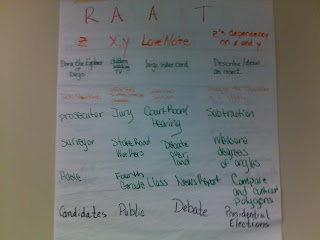RAFT is a writing
activity that promotes higher order thinking and gives students a fresh way to
think about how to approach
writing. I think this would be a great
summarizing activity at the end of a lesson or unit, as the students need to
have the concepts mastered to be able to do this independently. This strategy brings together students’
understanding of main ideas, organization, elaboration, and coherence.
Here’s how it’s broken down:
Role
- Who are you as the writer?
Audience
- To whom are you writing?
Format
- What are you writing?
Topic
- What is the subject or point of the writing?
The topic should be considered first and should come from
the objective(s) of your lesson. For
example, if students are learning about descriptive writing, the topic might be
to “describe the importance of adjectives in descriptive writing.” The writer could pretend to be a noun (role)
writing a persuasive speech (format) for adjectives (audience), trying to get
them to join the cause to improve their descriptive writing.
Good evening, wonderful adjectives! Tonight I want to ask for your help. As you know, we common nouns have been included in many brilliant students’ descriptive writing as they tell about interesting places they’ve been and exciting activities they enjoy. But we have noticed that there are only a few supportive adjectives joining the writing party. I am here this glorious evening to ask for your much-needed help in making the beautiful stories these kids write more interesting. We need help making a good impression when people read about us! I don’t want to be considered “just a tree.” So all you willing adjectives out there, Majestic, Willow, Green, and all the others, please come and support our important cause in helping the children become better writers!
Along those same lines, you could have students describe the
importance of capitalization and punctuation in writing (topic). The RAFT paper could be a text message
(format) from a teenager (role) to a friend (audience), describing the effects
of missing capitalization and punctuation.
(Can you tell we’ve been focusing on writing a lot lately in my class???
J )
So the charts would look something like this:
R
Role
|
A
Audience
|
F
Format
|
T
Topic
|
noun
|
adjectives
|
persuasive speech
|
Explain the importance of adjectives in
descriptive writing.
|
teen
|
friend
|
text message
|
Describe the effects of missing
capitalization and punctuation in writing.
|
Here are a few more examples from the participants at the
workshop. (I realize that some of these
posters have misspellings and other errors.
It drives me crazy too! Just think
of these as rough drafts.)
If you have any input on this strategy, please share! What grade level do you teach? What topics did you use? How successful was/is it in your classroom?





